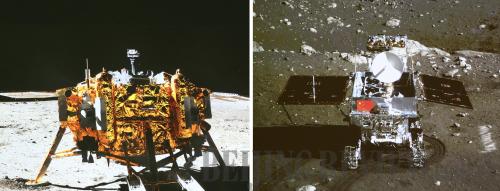|
 |
|
HERE WE ARE:Chang'e-3's lander and lunar roverYutuphotograph each other on the moon at 11:42 p.m. on December 15 (XINHUA) |
The last soft landing took place on August 18, 1976, when the Soviet probe Luna-24 touched down on the moon to collect samples. In the following 37 years, the moon has had nothing land on its surface.
The low success rate tells the difficulties of lunar explorations and landing. China, as a newcomer to the world's space exploration club, has been adhering to a path of domestically developed innovations.
Compared to Chang'e-1 and Chang'e-2 lunar probes, launched in 2007 and 2010 respectively, 80 percent of Chang'e-3's components and technologies are new, said Sun Zezhou, chief designer of the lunar probe.
Launched in January 2004, China's lunar exploration program includes orbiting, landing and returning to the Earth.
After the Chang'e-3 mission, China's lunar exploration program will enter a new stage of unmanned automatic sampling and return when it launches Chang'e-5, which will be an even more difficult endeavor with its own new challenges.
"The program's third phase will be more difficult because many technological breakthroughs must be made first, such as takeoff from the lunar surface, sampling encapsulation, rendezvous and docking in lunar orbit, and high-speed Earth re-entry, which are all new to China," said Wu Zhijian, a spokesman for the State Administration of Science, Technology and Industry for National Defense, at a press conference in Beijing on December 16.
As the backup probe for Chang'e-3, Chang'e-4 will also be adapted to test technologies to be used by Chang'e-5, according to Wu.
It was revealed that China plans to launch Chang'e-5 in 2017, which is expected to bring back up to 2kg of material from the lunar surface.
Researchers from the U.S. National Aeronautics and Space Administration have described Chang'e-3's operations on the moon as "a new scientific opportunity that could potentially enhance studies and observations of the lunar atmosphere."
Global cooperation
"The Chang'e-3 details tell me that the United States now absolutely must start communicating with the Chinese about lunar cooperation," said retired U.S. astronaut Buzz Aldrin, who was the second man to set foot on the moon after Neil Armstrong, in an interview with Aerospace America magazine.
Russian astronaut Vladimir Kovalenok said that the Chinese lunar program is on the right track and China can continue its path while taking into account the pros and cons of the lunar programs of the United States and the former Soviet Union.
"China is now a pioneer in this field, and its lunar missions will be a catalyst for lunar explorations by other countries, as the moon can serve as a basis for a jump on journeys to more distant places in the solar system," Kovalenok said.
"The European Space Agency (ESA) and China have recently signed a mutual cross support agreement that implies that the ESA can provide support to a Chinese mission through our deep space network (Estrack)," said Karl Bergquist, Administrator of ESA's International Relations Department.
"But the contrary could also be possible, i.e. that ESA would make requests to China to use Chinese antennas for an ESA mission. This has not yet happened, but I am sure it will happen in the next few years," Bergquist told China's Xinhua News Agency.
"This is a sign of the close relations that exists between the ESA and the Chinese space authorities," Bergquist added.
At the December 16 press conference, Wu said that China is always positive about international cooperation in lunar exploration. "We have had great cooperation with other countries and international organizations during previous missions," he noted.
Data collected through Chang'e-1 and Chang'e-2 probes are available to scientists across the globe, according to Wu. He also revealed that China shared information collected by Chang'e-1 with the ESA, and an ESA aerospace control center as well as three of its telecommand telemetry control stations took part in the Chang'e-3 mission.
"In the next stage of China's lunar exploration program, there will be more international cooperation," Wu said.
yuanyuan@bjreview.com | 